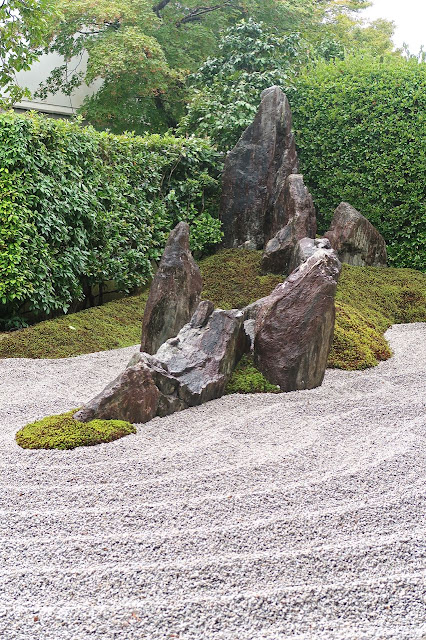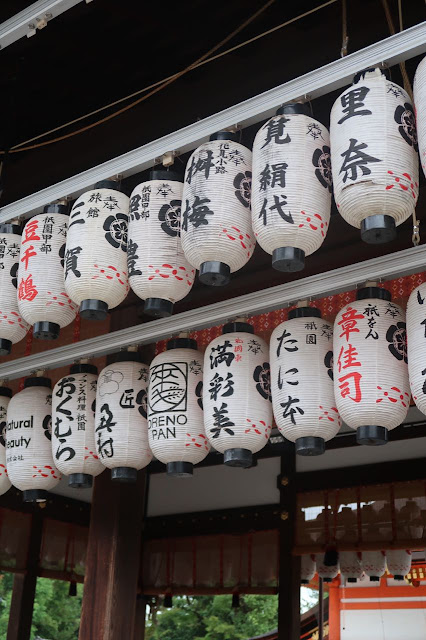Daitokuji Temple is the largest temple in northern Kyoto and a key site for the Rinzai sect of Japanese Zen Buddhism, which began to flourish with the rise to power of the samurai in the 12th century. Established in 1319 by Shohomyocho, also known as Daitokokushi, Daitokuji is a walled temple complex surrounded by 24 sub-temples that feature some of Japan's finest zen and rock gardens. The subtemple Daisen-in is one of the five most important Zen temples in Kyoto. It has five small extraordinary well maintained gardens. The gardens are all connected and tell the metaphorical story of journey through life according to Buddhism. The temple was founded in 1509 and by Kogaku Soko and was built between 1509 and 1513. Legend has it, that Soami, the great landscape designer, zen monk, and ink painter, has built the garden with his own hands.
Conveniently located near the famous temple complex of the same name, we had made lunch reservations at Daitokuji Ikkyu which specializes in shōjin ryōri, traditional vegetarian Buddhist cuisine. The oldest existing shōjin ryōri restaurant in Kyoto, Ikkyu has been feeding the monks at the Daitokuji temple complex since the 15th century. Shojin ryori was introduced to Japan from China by the monk Dogen, the founder of Zen Buddhism, whose practice emphasizes seated meditation and forbade killing animals for human consumption, which was believed to cloud the spirit and interfere with meditation. As a result, the meals they ate were made without meat or fish and also abstained from the use of pungent flavors like garlic and onion, and became the culinary foundation of shōjin ryōri. Seated in a private dining room, our tables were arranged facing the rock garden outside, in line with Zen Buddhism's emphasis on mindfulness and reflection, and were served a delicious bento box of vegan dishes by the owner of the restaurant who was dressed beautifully in a traditional kimono. After finishing our meal, the mother, daughter and chef son-in-law came out to wave us goodbye and thank us for coming, bowing, smiling and waving until we turned the corner. Such extraordinary kindness and gracious hospitality that left us quite overwhelmed — an unforgettable day.
Entrance gate to Daitoku-ji sub-temples
Entrance to Daisen-in Temple
Winding stone paths and lovely Japanese trees are found at every turn through Daitokuji
Beautiful Japanese temple architecture and gardens at Daitokuji
Scroll painting of the famous Japanese tea master Sen no Rikyū who is buried at Jukō-in
Daisen-in is one of the five most important Zen temples in Kyoto;
Legend has it that Soami, the great landscape designer, zen monk, and ink painter,
had built the garden with his own hands.
Rainwater bowl with baby duckweed
Lovely gates lead from one temple to another through garden paths
Gingko nuts growing on temple tree
Japanese pines and stone paths glisten with the soft rain
Garden entrance to Kōrin-in which is a sub-temple of Daitoku-ji
Kōrin-in Zen Garden founded in 1520
This famous garden was designed by Kinsaku Nakane who was a leading Japanese garden designer in the Showa period
Ancient stone lantern deep in the leafy canopy of a Zen moss garden
Totekiko at Ryōgen-ji is Japan's smallest zen garden, and represent the full power of cause and effect: how a drop, becomes a wave, and how a wave becomes the sea
Isshidan Garden: the raked white sand here represents the sea and the rocks represent
islands from Chinese mythology
Daitokuji-ikkyuu Buddhist Restaurant
which serves shōjin ryōri - traditional vegetarian Buddhist cuisine
Our private room with view into the zen rock garden
Sencha tea
Our wonderful hostess and daughter of the owner who served us our
Buddhist lunch and matcha tea
Vegan shojin-ryori in red lacquerware box
'Sacrificial tofu' with a sprinkling of crushed white sesame, fresh gluten simmered in soy sauce, lotus root, pickled turnip rolls with wasabi, sweet simmered kumquat, and boiled baby eggplant
garnished fresh gluten in the form of a green Japanese maple leaf
Purple yam stems marinated in miso and vinegar and garnished with edamame
Delicious steamed sticky rice with diced ginger and chestnut
Red lacquerware soup bowl, Japanese culture, the colour red is also believed
to be a talisman against evil spirits
Soup with a small bundle of yuba (tofu skin), matsutake mushroom and snow peas
in clear vegetarian dashi broth
Green tea jelly with super-salty flavourful black bean
Matcha tea
Daitokuji-ikkyuu has been feeding the monks at the Daitokuji temple complex for at least 500 years, and is the oldest existing shojin-ryori restaurant in Kyoto
Mrs. Tsuda (R), her daughter (C) and chef son-in-law (L)
came out of the restaurant to bid us goodbye with waves and deep bows
The two-storey vermilion gate of Yasaka Shrine, one of the most important shrines in Kyoto
Young ladies dressed in kimonos eying omamori - lucky charms or talismans
sold by Shinto priests
Japanese temple-shrine seal book area where for a small fee monks/priests
stamp your book with the name and day’s date with beautiful flowing calligraphy
and assorted red stamps, each with its own style
My Japanese temple book with calligraphy and red stamps
from Buddhist Temples and Shinto Shrines
Paper lanterns over the Yasaka Shrine prayer hall stage used for cultural performance throughout the year, particularly by the geisha from nearby districts
The Main Sanctuary (Honden), dates from 1654 and was built by the shogun of the day
Worshippers notify the gods of their presence by using the dangling cords
to ring the large bells above before praying at the altar
Shinto shrine maidens lead a wedding procession as we stood at the shrine
The bride and groom in traditional Shinto kimonos with red umbrella
held over them to protect from evil spirits
The wedding couple are escorted by family and friends,
to the haunting sound of a beating drum by shrine musicians











































No comments:
Post a Comment